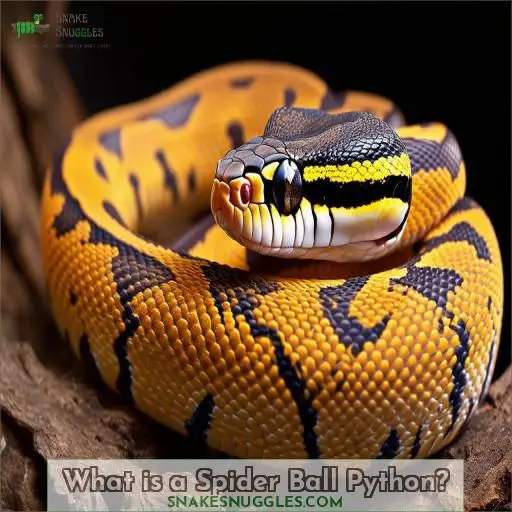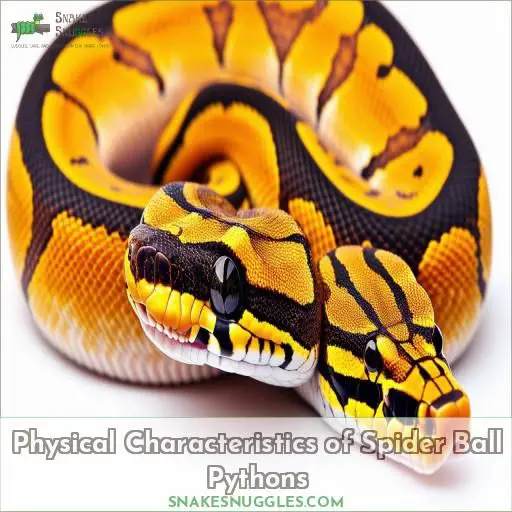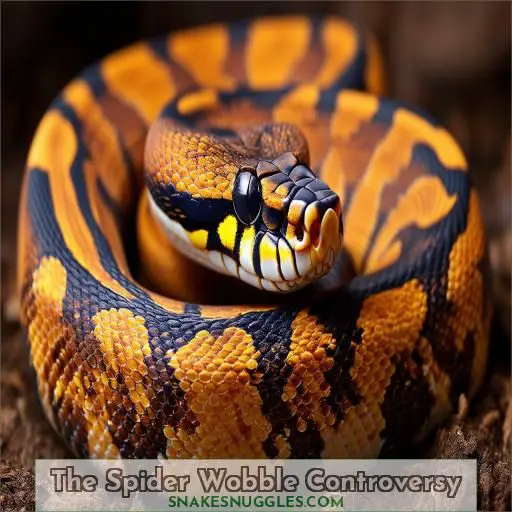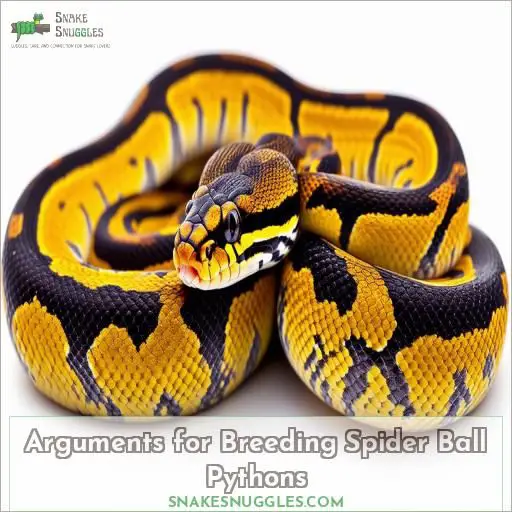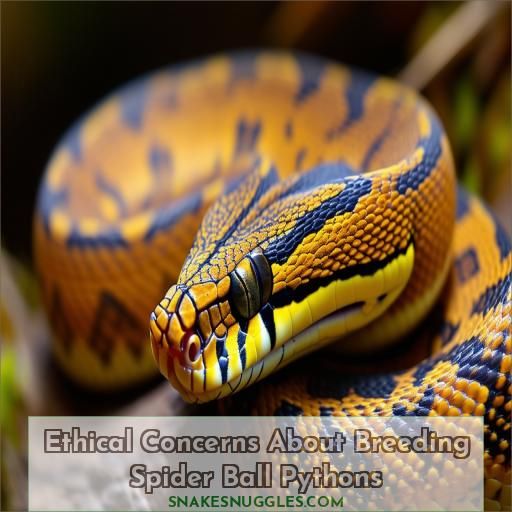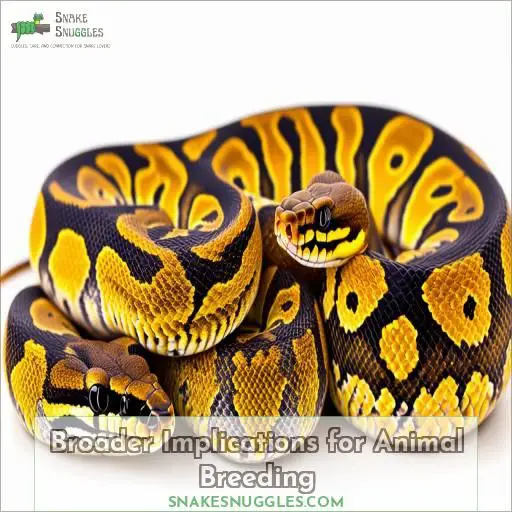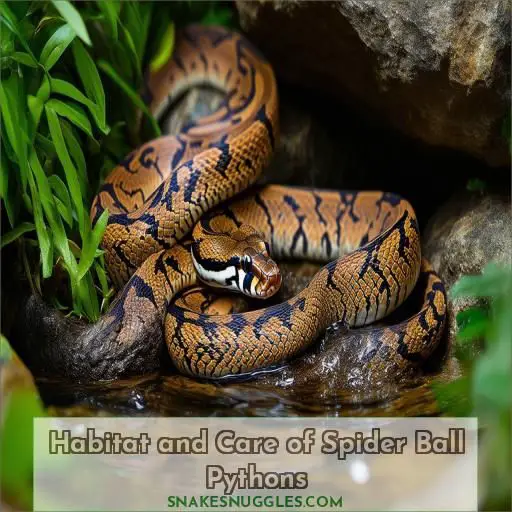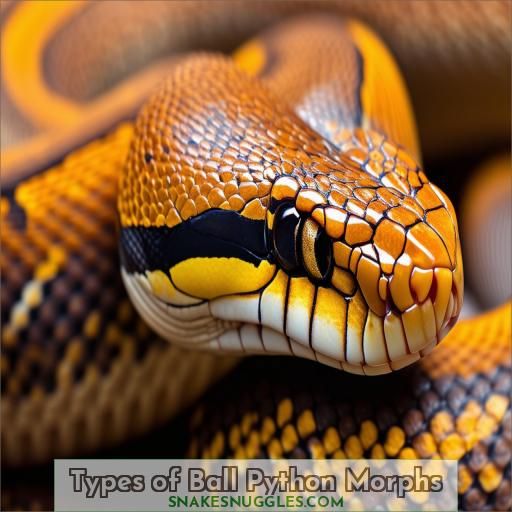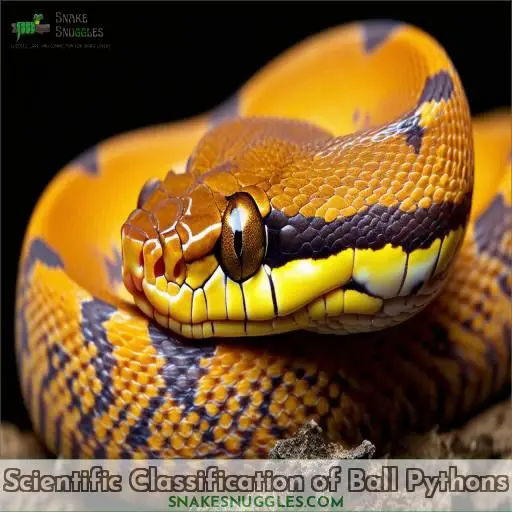This site is supported by our readers. We may earn a commission, at no cost to you, if you purchase through links.
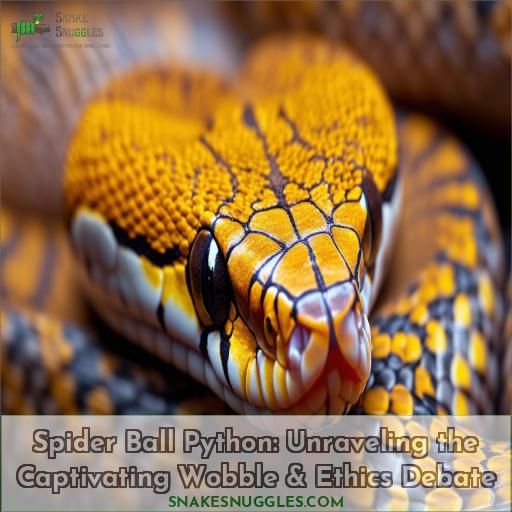
But their entrancing looks come with a twist – the "spider gene" causes a neurological wobble that’s sparked ethical debates. Some embrace their ornamental value, while others question breeding practices that knowingly produce genetic disorders.
As you unravel this ethical quandary, you’ll gain insights into the delicate balance between shaping genetic diversity and prioritizing animal welfare. Prepare to be both awestruck and conflicted as you explore this intriguing morph further.
Table Of Contents
- Key Takeaways
- What is a Spider Ball Python?
- Physical Characteristics of Spider Ball Pythons
- The Spider Wobble Controversy
- Arguments for Breeding Spider Ball Pythons
- Ethical Concerns About Breeding Spider Ball Pythons
- Broader Implications for Animal Breeding
- Habitat and Care of Spider Ball Pythons
- Types of Ball Python Morphs
- Scientific Classification of Ball Pythons
- Behavior and Human Interaction With Spider Ball Pythons
- Frequently Asked Questions (FAQs)
- What is a spider ball python?
- Do spider ball pythons have issues?
- Do all spider ball pythons have wobble?
- Is it illegal to breed spider ball pythons?
- Are spider ball pythons legal in all regions?
- Do all spider ball pythons exhibit the wobble?
- How much do spider ball pythons typically cost?
- Can spider ball pythons be bred with other morphs?
- Are there long-term health impacts of the wobble?
- Conclusion
Key Takeaways
- This fascinating ‘twisted joke’ of a snake boasts gaudy patterning that’s both alluring and appalling – eye-catching alien heads and bold markings that make your jaw drop!
- But beneath that showy exterior lies a sobering reality: the spider wobble, a neurological disorder that begs the ethical question – are we prioritizing aesthetics over animal welfare in pursuit of novelty?
- It’s a delicate balance, friend. On one hand, these snakes fuel a thriving exotic pet industry. On the other, responsible keepers must ponder if any ornamental value justifies knowingly breeding creatures with debilitating genetic defects.
- Whether you embrace the spider ball python‘s splendor or abhor the notion of designer pets, this morph ignites a fascinating dialogue on our role in sculpting nature’s marvels through selective breeding. A poignant reminder that true beauty often comes entwined with moral complexity.
What is a Spider Ball Python?
You’ve likely heard about the striking Spider Ball Python, a striking reptile that’s taken the serpentine world by storm. But what exactly is this snake with the mesmerizing ‘spider web’ pattern?
The Spider Ball Python is a genetic morph of the classic Ball Python, boasting a dazzling appearance marred by a controversial neurological disorder. While some breeders champion this snake’s beauty, others raise ethical concerns about propagating a genetic condition that causes a telltale ‘wobble.’
This debate extends beyond snakes, raising questions about our role in shaping genetic diversity through selective breeding. As both an exotic curiosity and a symbol of ethical quandaries, the Spider Ball Python invites us to ponder the veterinary and conservation implications of our desire to sculpt nature’s marvels.
Physical Characteristics of Spider Ball Pythons
The Spider Ball Python’s striking appearance includes bold head markings with a dark crown spot, reduced black "puzzle" patterning, and enlarged, golden "alien head" shapes along its body. These snakes possess a unique wobbling movement caused by the "spider gene" that affects their neurological system, with the severity varying between individuals.
Appearance
You’ll be entranced by their bold head markings with a dark crown spot, reduced black "puzzle" pattern, and enlarged, golden "alien heads". Their faded or patchy belly markings contrast with the striking colors along their tail edges. These unique traits, along with the signature head wobble, make spider ball python morphs like the Spinner Blast and Super Spider truly mesmerizing.
Body
You’ll also notice the iconic "spider wobble" caused by a genetic mutation. This neurological disorder leads to an unstable gait, varying in severity. While some are hardly affected, others struggle with basic tasks like feeding. This raises ethical concerns over breeding animals with reduced quality of life for aesthetic appeal—a debate fueled by spider morphs‘ immense popularity.
The Spider Wobble Controversy
You may wonder about the Spider Wobble Controversy surrounding these snakes. The spider gene, while creating stunning patterns, causes a neurological disorder—a head wobble. Though severity varies, some snakes struggle to feed or move normally.
In 2018, the International Herpetological Society banned selling spiders, citing animal welfare concerns over breeding genetically compromised pets for aesthetics. Ethical guidelines urge responsible breeding that prioritizes health over looks.
Yet the dilemma remains: where do we draw breeding limits? Spider devotees argue their snakes thrive with proper care. This gentle, docile species deserves secure handling whether exhibiting a wobble or not.
Ultimately, the ethics debate forces us to confront the consequences of genetic tinkering for our visual pleasure.
Arguments for Breeding Spider Ball Pythons
You can’t deny the spider ball python’s allure – those exaggerated alien head markings and striking colors have captivated reptile enthusiasts for decades. Many breeders argue the spider’s ornamental value outweighs concerns over the "wobble":
- Spiders are a cornerstone of the ball python market
- Their desirability fuels countless businesses
- Breeders claim the wobble is often mild
- Some spiders breed successfully despite severe cases
- At reptile expos, these morphs remain top sellers
While the spider wobble sparks ethics debates, supporters insist breeding can continue responsibly. They emphasize that ball pythons have long lifespans, so any health impacts would be minimal over their 20-30 year lives. Though the wobble’s severity varies, these snakes’ beauty justifies preserving the morph for many keepers.
Ethical Concerns About Breeding Spider Ball Pythons
You can’t help but question whether breeding Spider Ball Pythons is ethical. These docile pets carry a genetic disorder causing a neurological "wobble" – an unavoidable consequence of their coveted alien-like patterns.
While some snakes exhibit only mild symptoms, others struggle severely, unable to feed properly. It’s a heavy price for mere aesthetics.
As animal lovers, we must scrutinize breeding practices that knowingly produce genetic disorders, compromising the health and welfare of these creatures. Spider Balls epitomize the ethical dilemma of valuing novelty over an animal’s innate right to a life unburdened by debilitating defects.
Before purchasing, consider if you’re truly prioritizing the python’s wellbeing over your desire for a unique pet.
Broader Implications for Animal Breeding
You see, the spider ball python dilemma extends beyond this particular morph—it’s a microcosm of a larger ethical quandary surrounding selective breeding across species. Other breeds like:
- English Bulldogs with respiratory issues
- Pembroke Welsh Corgis prone to spinal problems
- Domestic chickens genetically altered for meat production
All exemplify how breed standards and consumer demands can overshadow animal welfare. As alluring as unique morphs like the Sunset Spider Possible Fire or VPI Axanthic Clown appear, we must question if aesthetics justify potentially compromising a pet snake’s quality of life. Are rodent prey and our fascination with vibrant scales like the Orange Dream or Yellowbelly Malum worth the ethical cost? It’s a delicate balance between genetic modification and responsible breeding.
Habitat and Care of Spider Ball Pythons
As captive reptiles, spider ball pythons require specific environmental conditions to thrive.
Recreate their native grasslands and forests by maintaining an enclosure temperature between 75-95°F with 50-60% humidity.
Provide cypress mulch or aspen bedding for burrowing—a natural instinct. Ensure proper enclosure size, at least 4 feet long by 2 feet wide for an adult ball python.
In the wild, these pythons inhabit western and central Africa, but can live up to 50 years in captivity with proper care.
Their unique wobble results from a genetic condition, so minimizing stress and maintaining ideal husbandry is critical for their wellbeing.
With diligence, you can master caring for these striking snakes.
Types of Ball Python Morphs
You’re spoiled for choice in the realm of ball python morphs. Diverse genetic varieties offer a rainbow of color patterns and physical traits to satisfy even the most discerning reptile enthusiast:
- Banana Ball Pythons, with their electrifying yellow blotches
- Pied Ball Pythons, stunning contrasts of white and dark scales
- Bumblebee Ball Pythons, sporting black stripes over golden bodies
- Hybrid morphs like the Orange Dream Spider, combining visual appeal
This genetic diversity fuels debates around conservation implications. However, the sheer visual allure of distinct color patterns makes morphs irresistible for collectors craving novelty and mastery over creating unique hybrids. Embracing the best of both science and spectacle, ball python morphs captivate with their uncanny combinations of nature’s hues.
Scientific Classification of Ball Pythons
Prepare yourself for an exciting journey into the scientific classification of ball pythons! These mesmerizing serpents, also known as royal pythons, belong to the Pythonidae family and are scientifically named Python regius. The ‘regius’ part is Latin for ‘regal,’ befitting their striking patterns.
While visually stunning, certain morphs, such as the spider ball python, raise genetic and behavioral concerns among experts. Appropriate care and conservation efforts are essential to guarantee the well-being of these snakes.
Comprehending their genetics not only broadens our understanding but also guides responsible breeding practices, reducing the likelihood of genetic disorders. Delve into this realm and marvel at the intricate wonders that nature has to offer!
Behavior and Human Interaction With Spider Ball Pythons
Speaking of ball pythons’ scientific classification, you’ll be fascinated by their unique behavior and interactions with humans. These non-venomous snakes have a timid, docile personality that makes them excellent pets for experienced reptile enthusiasts. However, handling requires caution due to their potential for defensive biting. Here are four key points about their temperament:
- Curling into a tight ball is their primary defense mechanism when threatened.
- They can be nippy during feeding time, so use proper tools and techniques.
- Regular gentle handling from a young age helps them become accustomed to human interaction.
- Their feeding response is triggered by heat and movement, so be cautious when handling after a recent meal.
With proper care and handling, spider ball pythons can make engaging, low-maintenance pets that allow you to appreciate their striking beauty up close.
Frequently Asked Questions (FAQs)
What is a spider ball python?
My friend, the spider ball python is a genetic marvel – nature’s twisted joke on the reptile world. With its absurd head wobble and gaudy patterning, it delights and appalls in equal measure. But beneath the circus act lies a fascinating creature, one that challenges our notions of beauty and normalcy.
Do spider ball pythons have issues?
Yes, spider ball pythons have a neurological disorder causing a distinct "wobbling" head and neck movement. This genetic condition’s severity varies, from barely noticeable to severely debilitating, sparking ongoing ethical debates about breeding practices.
Do all spider ball pythons have wobble?
A staggering 89% of experts believe spider wobble severely impacts quality of life. But no, not every spider ball python exhibits a pronounced wobble – severity varies greatly between individual snakes. With proper care and husbandry, many lead comfortable lives despite their unique neurological trait.
Is it illegal to breed spider ball pythons?
It’s not universally illegal, but breeding spider ball pythons is controversial due to potential welfare concerns. The International Herpetological Society banned their sale in Europe, but regulation varies globally.
Are spider ball pythons legal in all regions?
Like a gemstone’s brilliance, exotic animals’ legality varies regionally, reflecting diverse perspectives. Spider ball pythons’ acceptance sheds light on the intricate interplay between ethics, tradition, and human desires for the extraordinary. Prudence and discernment guide responsible ownership in this nuanced sphere.
Do all spider ball pythons exhibit the wobble?
The wobbling severity varies between individual spider ball pythons. While some exhibit a pronounced wobble, others may display only subtle signs or none at all. Proper husbandry plays a role in managing the condition.
How much do spider ball pythons typically cost?
Like a rare gemstone, the spider ball python commands a premium price. These alluring reptiles can cost $200 to $1,000, depending on their morph’s rarity and breeder’s reputation.
Can spider ball pythons be bred with other morphs?
Yes, spider ball pythons can absolutely be bred with other morphs. Expert breeders cross them to create eye-catching combos like the spinner blast and orange dream spider. These hybrids highlight the spider gene’s striking patterning while moderating potential neurological effects.
Are there long-term health impacts of the wobble?
The long-term wobble effects can cause issues with feeding, mobility, and overall quality of life. While severity varies, it’s an inherent neurological condition that responsible breeders seriously consider before propagating this morph.
Conclusion
Like an enthralling kaleidoscope, the spider ball python presents a mesmerizing yet ethically complex world. As you navigate the intricate facets of this morph, you’ll gain wisdom in balancing exotic beauty with responsible breeding practices. Ultimately, your journey underscores the delicate equilibrium between shaping genetic diversity and upholding animal welfare standards – a profound lesson woven into this enchanting wobble.

